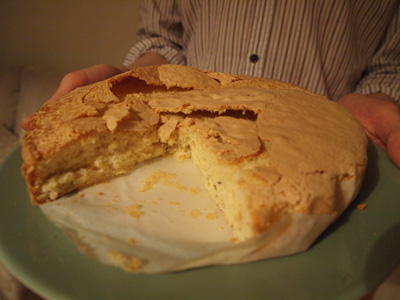Before we knew it, Advent was upon us and it was time for us to roll out some mince pies and mulled wine for our final Cooking Up History Session this year. Our seasoned cookery volunteers Christina and David joined us to create Lemon Caudle and Mammas Mince Pyes from our Georgian-era Cookbook of Unknown Ladies. We were also delighted to welcome food historian Annie Gray to our session. With a professional in our midst, we were keen to show off the knowledge and skills we’d accumulated over the past year, as well as learning some new tips on historic cookery.

Our mincemeat pies were based on the recipe for Mammas Mince Pyes in The Cookbook of Unknown Ladies
We began with our mince pies. The recipe was met with some hesitancy by the group, as the list of ingredients included a rather hefty amount of beef tongue. Fruit, spice, sugar… and meat? It challenged our preconceived idea of a mince pie should be! But Annie allayed our fears, telling us that once we’d tasted a proper mince meat pie, we’d never want to go back to modern shop bought ones. We determined to stay true to our 18th century ladies and forged ahead with the recipe.

David kicked off our mince pie prep by shredding the ox tongue
David began dicing our meat: cured ox tongue. We’d decided against preparing the tongue from scratch, as the skinning and boiling would have taken more time and space than we had available. There was the added bonus, of course, that for the more squeamish among the group the meat looked and handled just like ham. We then added an fruity mix of apples, currants, raisins and sweetmeats (dried apricots, dried cranberries and candied peel and ginger) to the mixture, stirring well to combine. Sugar and spice were then sprinkled in, along with a good measure of sherry.

The mincemeat mixture, ready for putting in the pie cases
Christina had expertly rolled and lined a muffin tin with shortcrust pastry. We filled some of the pastry cases with the meaty mincemeat and others with vegetarian mincemeat so that we could compare ‘Mammas mince pyes’ with their modern day counterparts.

Annie showed us how to make and fill a hand-raised pie
Annie then showed us how to craft a hand-raised mince pie, building up the pastry little by little to create a free-standing pie case. We were all very impressed by Annie’s expertise!

Annie’s hand-raised pie case, filled and ready for the pastry lid
After just over half and hour in the oven, it was time to take out the pies and have a taste. Golden brown with crisp short-crust pastry, they were a proper festive temptation and an ideal start to our Christmas celebrations. Our concerns about the meat had been unwarranted. Much to our surprise, the ox tongue added a richness to our mince pies which really enhanced the taste.

Our golden mincemeat pies, ready for tasting!
Christina noted that there was something extremely satisfying about all the ingredients – apples, raisins, sultanas etc and that they blended surprisingly well. The sherry gave the mixture real depth, and the nutmeg, cinnamon, allspice and ginger provided the warm spice flavours that we have come to associate so closely with Christmas. But unlike the mince pies we buy in the shops today, these 18th century style ones weren’t too sweet – the sugar was really well balance by the saltiness of the tongue. The effect was really very pleasing.

Annie’s hand-raised pie was the star of the session!
Lemon caudle
Mince pies baked, we went on to make our lemon caudle. It was a quick and relatively easy recipe.

Christina getting the lemon juice ready for our caudle
We gently heated our milk on the stove and curdled it with freshly-squeezed lemon juice. Once we were sure that all the milk had turned, we strained off the curds and discarded them. The whey was then poured over a couple of egg yolks in a large bowl, whisked all the while, and once combined was returned to the saucepan on the hob. We were really careful to keep stirring the mixture and not let it heat up too much, as while we wanted it to thicken, we definitely didn’t want the mixture to split a second time!

Curdling milk to make lemon caudle. We turned the milk with lemon juice.
As the caudle cooked, we began to get a better idea of what we might expect from it in terms of taste and texture. Christina thought the caudle would be a bit like custard, while Annie suggested that it would be warming and comforting – perfect for warding off the cold of winter.

Lemon caudle, ready for serving!
We were pleased to find our end product a pleasant, milky drink, which led some of our group to compare it to our modern day equivalent of ‘Ovaltine’. The rose water, now so strongly associated with our Georgian cookery, still added the slightly unfamiliar taste to our drink, despite the little we had added. Still unsure of this perfumed taste, Christina and Kim agreed that one glass of this was more than enough, despite its soothing taste and texture.
As a post dinner treat, the combination of our mince pies and lemon caudle worked surprisingly well together. Christina was so blown away by our mince pies, she claimed they were the best she’d ever tasted! A comment to be cherished! Although our lemon caudle hadn’t tickled anyone’s tastebuds to quite the same extent, we had also enjoyed trying it out. Relaxing with a glass of mulled wine, we went on to discuss the pros and cons of historic food recreation with Annie…a lovely conclusion to a busy afternoon!
You can find the recipes we followed for the mince pies and lemon caudle on our Cooking Up History page. Why not give them a go?




















